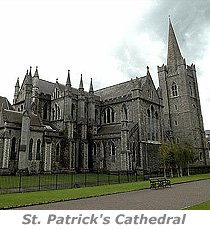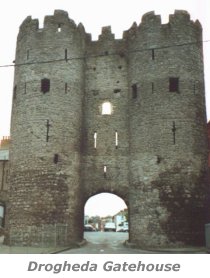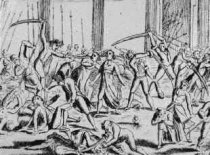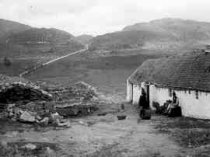Before the English Civil Wars, Oliver Cromwell was neither an important member of Parliament nor was he a person with any military experience. Most English professional soldiers of the day were royalists, and anyone of wealth who could raise troops for the English Parliament was encouraged to do so.
Cromwell chose his men for their Protestant religious fervor and implemented strict Puritan discipline. He promoted officers by their ability rather than by their wealth which was unheard of at the time.
In Ulster, Protestant Parliamentarian General George Monk was under severe pressure to succumb to Catholic Royalist demands, while in Dublin Governor Colonel Michael Jones was virtually encircled by the forces of the Earl of Ormonde and Lord Inchiquin. With fears that Ireland might become the base for a Royalist resurgence, the English Government dispatched Oliver Cromwell to quench the growing embers of revolt.
The brutality of Cromwells Scottish campaign was far less than what would be felt by the Irish. In 1649, Cromwell arrived in Ireland and took merciless revenge at Drogheda and Wexford for the Ulster massacres of 1641.
Cromwell was delayed in Wales in August while awaiting funding for the Irish campaign. His men would not board the ships to Ireland until they had been paid and many started deserting.
Monk’s predicament in Ulster was becoming precarious and he had begun negotiations with the Royalist besiegers. Perhaps more than anything, this spurred the House of Commons to expedite Cromwell’s financial needs saying:
“We doth detest and abhor” any thoughts of negotiation with Popish Rebels in Ireland “who have had their hands in shedding innocent blood there.”
 A desperate Colonel Jones broke out of Dublin on August 2nd of 1641 attacking the superior force surrounding the city. With an army of 5,000 underfed men, short of arms and supplies, Jones faced 19,000 of Ormonde’s men defeating them and taking an estimated 2,000 prisoners and inflicting 4,000 fatalities.
A desperate Colonel Jones broke out of Dublin on August 2nd of 1641 attacking the superior force surrounding the city. With an army of 5,000 underfed men, short of arms and supplies, Jones faced 19,000 of Ormonde’s men defeating them and taking an estimated 2,000 prisoners and inflicting 4,000 fatalities.
The victory in Dublin was seen as nothing short of divine intervention for if Jones had not succeeded against Ormonde, Cromwell would have been forced to a landing spot further south causing further delay to his Irish campaign. Of Jone’s victory, Cromwell wrote:
“This is an astonishing mercy, so great and seasonable as indeed we are like them that dreamed. What can we say! The Lord fill our souls with thankfulness, that our mouths may be full of His praise.”
Cromwell landed at Ringsend in Dublin on 15 August 1649 with 35 ships. His support came from Henry Ireton who arrived on 17 August with an additional 77 ships at a port further south.
After Dublin, Ulster became Cromwell’s top priority. The conditions there had worsened since the Royalist defeat at Dublin and many of the vanquished troops had regrouped to the north in preparation of an assault on Ulster. On the 31st of August Cromwell’s forces set out for the town of Drogheda, which was a vital key to his campaign.
Ormonde had fallen back from Drogheda but had left Sir Arthur Aston in command with a nearly all Catholic garrison force of 2,000 foot soldiers, and 320 horse cavalry. Drogheda was well provisioned and had formidable walls protecting the town 20 feet high, and 6 feet thick at the bottom narrowing to 2 feet at the top. Anston was so confident that the town’s fortifications would allow his troops to withstand an attack by Cromwell that he proudly said:
“He who could take Drogheda could take Hell!”
Cromwell immediately began to set up artillery upon his arrival at Drogheda. Eleven siege guns and 12 field cannons were set up just south of the town at a place still known today as ‘Cromwell’s Mount’.
His men were under strict rules of behavior. Two of his soldiers who were caught stealing hens from some Irish women on the Dublin Road were hanged. Aston had predicted that hunger and disease would take a toll on his attackers. Perhaps because of the executions, the locals did not seem to fear Cromwell’s presence, and in fact the inhabitants of the countryside surrounding Drogheda began selling food to his camp.
On the 10th of September Cromwell made his first call to Aston for surrender:
“Having brought the army belonging to the Parliament of England before this place, to reduce it to obedience, to the end the effusion of blood may be prevented, I thought it fit to summon you to deliver the same into my hands to their use. If this be refused you will have no cause to blame me.”
The rules of war at the time were quite clear and known throughout Europe. Anston knew that if the attackers would breach the walls during a siege, no quarter would be given the defenders.
 The harbor of the Boyne River was blocked by the Parliamentary fleet under Sir George Ayscough and Aston knew that he would be without reinforcement or support from Ormonde. Drogheda was not united and many within the city walls favored the English Parliamentary force. To make matters worse for Anston, his own grandmother, Lady Wilmot, was discovered plotting with other ladies of the town to betray the Royalists to the invading English.
The harbor of the Boyne River was blocked by the Parliamentary fleet under Sir George Ayscough and Aston knew that he would be without reinforcement or support from Ormonde. Drogheda was not united and many within the city walls favored the English Parliamentary force. To make matters worse for Anston, his own grandmother, Lady Wilmot, was discovered plotting with other ladies of the town to betray the Royalists to the invading English.
Aston refused to surrender and Cromwell’s cannons fired until the walls of the city near St. Mary’s church began to crumble. The first breach was only big enough for Cromwell’s foot soldiers who met with such fierce resistance that they were forced to retreat. In a letter to the Speaker of the English Parliament, William Lenthall, Cromwell wrote:
“Upon Tuesday the 10th of this instant, about five o’clock in the evening, we began the Storm: and after some hot dispute we entered, about seven or eight hundred men; the Enemy disputing it very stiffly with us. And indeed, through the advantages of the place, and the courage God was pleased to give the defenders, our men were forced to retreat quite out of the breach, not without some considerable loss”.
The second attempt at the wall was joined by Cromwell himself with more success in the face of the same resistance. The Parliamentarians gained the Royalists entrenchment and St. Mary’s church. Reinforcements of 7,000 to 8,000 arrived under the command of Colonel Isaac Ewers while Aston and his men retreated to Millmount. Of the event Cromwell wrote:
“The Governor, Sir Arthur Ashton, and divers considerable Officers being there, our men getting up to them, were ordered by me to put them all to the sword. And indeed, being in the heat of action, I forbade them to spare any that were in arms in the Town: and, I think, that night they put to the sword about 2,000 men;–divers of the officers and soldiers being fled over the Bridge into the other part of the Town, where about 100 of them possessed St. Peter’s Church-steeple, some the west Gate, and others a strong Round Tower next the Gate called St. Sunday’s. These being summoned to yield to mercy, refused. Whereupon I ordered the steeple of St. Peter’s Church to be fired, when one of them was heard to say in the midst of the flames: ‘God damn me, God confound me; I burn, I burn.'”
Not all who surrendered to Cromwells forces were killed;
“When they submitted, their officers were knocked on the head; and every tenth man of the soldiers killed; and the rest shipped for the Barbadoes. The soldiers in the other Tower were all spared, as to their lives only; and shipped likewise for the Barbadoes.”
In a letter commenting on the aftereffects of the Drogheda siege, Ormonde wrote:
“It is not to be imagined how great the terror is that these successes and the power of the (English) have struck into this people.” He continued that his forces “are yet so stupefied that it is with great difficulty I can persuade them to act anything like men towards their own preservation.”
It was said that over 3,500 people, including women and children, were slaughtered at Drogheda.
 Cromwell and his army encamped at the walls of Wexford on October 1, 1649. It was through Wexford that the Catholic Confederates received their arms and kept in touch with supporters in foreign countries making its capture of high importance.
Cromwell and his army encamped at the walls of Wexford on October 1, 1649. It was through Wexford that the Catholic Confederates received their arms and kept in touch with supporters in foreign countries making its capture of high importance.
Ormonde also realized the importance of Wexford and sent 1,000 infantry and 300 cavalry to reinforce the garrison already there. The distrust of Ormonde by the townspeople was so strong that they initially refused entry to Ormonde’s forces, doing so only after the Parliamentarians arrived.
On October 11, Captain James Stafford gave Cromwell entrance to the town. The scenes that followed mirrored those at Drogheda. Many Franciscans and other priests were killed. Three hundred women were massacred while standing at the cross in the public square hoping that being near the cross would soften the hearts of the Christian soldiers. Instead it identified them as Catholics, and they were put to death. An estimated 2,000 were killed at Wexford.
Several similar battles ensued in Cromwell’s conquest of Ireland including Wexford, Kiltenan, Dundrum, Ballynakill and Kildare until he and other Parliamentarians next converged on Kilkenny, headquarters of the Confederacy. Upon payment of 2,000 pounds sterling, the citizens of Kilkenny were protected from looting, and the officers and soldiers were allowed to march out disarmed for two miles. The clergymen also were allowed to march out.
Many of the dispossessed joined the Tories in the woods and hills. Although they were outlawed by the Government, some of them were regarded as heroes by the Irish. They became a serious menace to the new planters, raiding their land, attacking and killing them. The Government offered large rewards for their capture so that Tory hunting and Tory murder became common pursuits.
Government agents were also employed to round up beggars, widows and orphans. Executions were a daily occurrence and it is estimated that nearly 15,000, mostly children, were transported to the sugar plantations of the West Indies as slaves and indentured servants.
The Puritans not only persecuted the Catholics, but Ulster Presbyterians, members of the Church of Ireland, and those of other minority religions as well. Priests were hanged, exiled or transported to the West Indies with Puritan preachers brought from England to replace them.
 By 1653 the English had completely subjugated the entire island. The combination of massacres, pestilence, and starvation was estimated to have killed between half and two-thirds of the Irish people. Thousands of others were shipped off into slavery in the American colonies and the West Indies. Those sent to the Indies would become the ancestors of the ‘Black Irish’ of Montserrat, the Caribbean island where Irish was still spoken up to the 1800s, and where many families have Irish names.
By 1653 the English had completely subjugated the entire island. The combination of massacres, pestilence, and starvation was estimated to have killed between half and two-thirds of the Irish people. Thousands of others were shipped off into slavery in the American colonies and the West Indies. Those sent to the Indies would become the ancestors of the ‘Black Irish’ of Montserrat, the Caribbean island where Irish was still spoken up to the 1800s, and where many families have Irish names.
The Adventurers’ Act had been a call to members of Parliament, merchants and tradesmen to lend the money required to raise an army to subdue the rebels in Ireland. The adventurers were offered two and a half million acres
of Irish land, which would be confiscated at the end of the rebellion, as security of their money. Suppliers of provisions and ammunition to the army also had to be paid, and the adventurers were demanding to be recompensed.
The lands of the defeated Irish and Old English Catholics were declared confiscated and preparations began for its distribution to the various people to whom the government was indebted.
The Irish landowners were ordered to move west of the River Shannon to the province of Connacht before May 1, 1652, or risk death. The poor people were allowed to remain as tenants, tradespeople, and laborers.
In August of 1652, the English Parliament passed the act for settling Ireland. The land was surveyed while the English government would decide who should forfeit land. The owners of Irish land be they Catholic, Protestant, or Old English would suffer loss by degrees of guilt, and with penalties assessed dependent upon their role in the rebellion be it major or minor.
While some were dispossessed simply for being Catholic, many Protestant and Old English landowners were allowed to retain their land on payment of heavy fines. Plans had also included forcibly moving the Ulster-Scots from Ulster to the South, but these were never acted upon as the Protestants were considered to be less of a security risk.
 Members of the army, who had not been paid in 18 months, would be the first to be settled on the land vacated by the Irish, followed by the adventurers.
Members of the army, who had not been paid in 18 months, would be the first to be settled on the land vacated by the Irish, followed by the adventurers.
In September of 1653, Parliament issued the order for the commencement of what would come to be known as the Cromwellian Plantations. Under penalty of death by hanging, no Irish man, woman or child was to be found east of the River Shannon, after 1 May 1654.
The Irish landowners who had been implicated in the rebellion were to be transplanted to Connacht and to Clare, west of the Shannon, and kept under close scrutiny by the military settlers. The only people who would be allowed to remain east of the Shannon were those who could prove that they had been faithful to the English cause.
Connacht and Clare were chosen for this transplantation because they were surrounded by water except for a ten mile stretch of land which would be protected by a series of forts. Members of the English military would settle in a one mile perimeter, called The Mile Line, around Connacht and Clare “to confine the transplanted and to cut them off from relief by sea.”
The resident landowners of Connacht and Clare also came within the category of transplanter. Their land holdings were reduced and they were often transplanted from one parish to another where the native landowners would regard them as enemies.
There were three categories of transplanter; proprietors, tenants and landless. The proprietors would have lands assigned to them corresponding in quality to those they had left.
The tenants would be assigned land as tenants of the state in proportion to the number and kind of livestock they brought with them. A horse would fetch four acres of land, while a cow would bring three.
The landless were allowed to settle on state-owned land on the provision that they were not within ten miles of the Shannon.
The last adventurer was settled on 1 May 1659 marking the end of the Cromwellian Plantations. The Roman Catholics owned about three-fifths of Ireland before the Irish Rebellion of 1641. By the 1680’s, they had lost all but one-fifth of it.
 Puritan rule under Oliver Cromwell, Lord Protector, had been extremely harsh. Cromwell died in 1658 and was succeeded as Lord Protector by his son Richard. In order to raise money and settle such differences, Richard was forced to dissolve the Protectorate and reinstate the Rump Parliament in January 1659. Bitter arguments between the Parliament and the military resulted in an Army Council which would break away, taking Richard into their power and forcing him to dissolve the Rump in May. The Army Council then agreed with a reassembled Long Parliament upon the Lord Protector’s dismissal. Richard submitted to Parliament’s decision on 25th May 1659
Puritan rule under Oliver Cromwell, Lord Protector, had been extremely harsh. Cromwell died in 1658 and was succeeded as Lord Protector by his son Richard. In order to raise money and settle such differences, Richard was forced to dissolve the Protectorate and reinstate the Rump Parliament in January 1659. Bitter arguments between the Parliament and the military resulted in an Army Council which would break away, taking Richard into their power and forcing him to dissolve the Rump in May. The Army Council then agreed with a reassembled Long Parliament upon the Lord Protector’s dismissal. Richard submitted to Parliament’s decision on 25th May 1659
Charles II was restored to the throne in May of 1660 to the great joy of the majority of the people. Catholics and others were again allowed to practice their religion in peace.
The Duke of Ormonde was made Viceroy of Ireland in 1661, and in 1662 the Act of Settlement was passed by the Irish Parliament as part of the Restoration land settlement.
Under the Act of Settlement people who could prove they were innocent of any part in the rebellion were to be restored and compensated with lands elsewhere.
A court of claims was convened in January 1663 to hear the pleas. The court heard 829 cases and awarded decrees of innocence to more than 550 Catholics and about 150 Protestants. With hundreds of cases yet to be heard, the court was disbanded on August 21, 1663. It took so long for the Plantation to actually get under way that by the time of the Restoration many people had not moved and were restored to their old lands.
In 1664, England seized New Amsterdam from the Dutch in America changing its name to New York. The Plague hit London in 1665, only to be followed by London’s Great Fire of 1666.
 In 1667 the Dutch fleet would defeat the English on the Medway river, and in 1668 England would enter into an alliance with the Netherlands and Sweden against France. In 1670 the Secret Treaty of Dover was made between Charles II and Louis XIV of France to restore Roman Catholicism to England.
In 1667 the Dutch fleet would defeat the English on the Medway river, and in 1668 England would enter into an alliance with the Netherlands and Sweden against France. In 1670 the Secret Treaty of Dover was made between Charles II and Louis XIV of France to restore Roman Catholicism to England.
By this time, the Caldwell line of William of Straiton through John Caldwell who married Mary Sweetenham had been in Ireland for over forty years.
John Caldwell who married Mary Holmes would have been eleven years, and his brother, Sir James, only seven at the outbreak of the Irish Rebellion in 1641. This was the world of our Ulster-Scot Caldwell ancestors and a glimpse of the faced economic and political hardships and religious intolerance that they lived with daily.
Sources:
- Desmond’s Concise History of Ireland – Jerry Desmond
- Encyclopedia Britanica
- Britannia
- The Plantation of Ireland – Brian Orr
- The Scotch-Irish: The Scot in North Britain, North Ireland, and North America – Charles Hanna
- Oliver Cromwell’s Letters and Speeches – Thomas Carlyle
- Doyle Clan
- Catholic Encyclopedia
- Red Hand, the Ulster Colony – Constantine Fitzgibbon
- Hoganstand.com
- Irish Republican Socialist Movement
